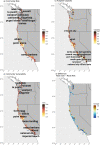Social-ecological vulnerability of fishing communities to climate change: A U.S. West Coast case study
- PMID: 35976855
- PMCID: PMC9385011
- DOI: 10.1371/journal.pone.0272120
Social-ecological vulnerability of fishing communities to climate change: A U.S. West Coast case study
Abstract
Climate change is already impacting coastal communities, and ongoing and future shifts in fisheries species productivity from climate change have implications for the livelihoods and cultures of coastal communities. Harvested marine species in the California Current Large Marine Ecosystem support U.S. West Coast communities economically, socially, and culturally. Ecological vulnerability assessments exist for individual species in the California Current but ecological and human vulnerability are linked and vulnerability is expected to vary by community. Here, we present automatable, reproducible methods for assessing the vulnerability of U.S. West Coast fishing dependent communities to climate change within a social-ecological vulnerability framework. We first assessed the ecological risk of marine resources, on which fishing communities rely, to 50 years of climate change projections. We then combined this with the adaptive capacity of fishing communities, based on social indicators, to assess the potential ability of communities to cope with future changes. Specific communities (particularly in Washington state) were determined to be at risk to climate change mainly due to economic reliance on at risk marine fisheries species, like salmon, hake, or sea urchins. But, due to higher social adaptive capacity, these communities were often not found to be the most vulnerable overall. Conversely, certain communities that were not the most at risk, ecologically and economically, ranked in the category of highly vulnerable communities due to low adaptive capacity based on social indicators (particularly in Southern California). Certain communities were both ecologically at risk due to catch composition and socially vulnerable (low adaptive capacity) leading to the highest tier of vulnerability. The integration of climatic, ecological, economic, and societal data reveals that factors underlying vulnerability are variable across fishing communities on the U.S West Coast, and suggests the need to develop a variety of well-aligned strategies to adapt to the ecological impacts of climate change.
Conflict of interest statement
The authors have declared that no competing interests exist.
Figures






References
-
- Bhattachan A, Jurjonas MD, Moody AC, Morris PR, Sanchez GM, Smart LS, et al.. Sea level rise impacts on rural coastal social-ecological systems and the implications for decision making. Environmental Science and Policy. Elsevier Ltd; 2018. pp. 122–134. doi: 10.1016/j.envsci.2018.10.006 - DOI
-
- Kunz M, Mühr B, Kunz-Plapp T, Daniell JE, Khazai B, Wenzel F, et al.. Investigation of superstorm Sandy 2012 in a multi-disciplinary approach. Nat Hazards Earth Syst Sci. 2013;13: 2579–2598. doi: 10.5194/nhess-13-2579-2013 - DOI
-
- Padgett J, DesRoches R, Nielson B, Yashinsky M, Kwon O-S, Burdette N, et al.. Bridge Damage and Repair Costs from Hurricane Katrina. J Bridg Eng. 2008;13: 6–14. doi: 10.1061/(ASCE)1084-0702(2008)13:1(6) - DOI
-
- Wang X, Xu LL, Cui SH, Wang CH. Reflections on coastal inundation, climate change impact, and adaptation in built environment: progresses and constraints. Adv Clim Chang Res. 2020;11: 317–331. doi: 10.1016/j.accre.2020.11.010 - DOI
-
- Cheung WWL, Lam VWY, Sarmiento JL, Kearney K, Watson R, Zeller D, et al.. Large-scale redistribution of maximum fisheries catch potential in the global ocean under climate change. Glob Chang Biol. 2010;16: 24–35. doi: 10.1111/j.1365-2486.2009.01995.x - DOI
Publication types
MeSH terms
Associated data
LinkOut - more resources
Full Text Sources
Other Literature Sources
Medical
Miscellaneous

